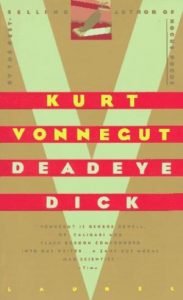 By Kurt Vonnegut
By Kurt Vonnegut
ISBN13: 978-0-38-533417-4
Publication Year: 1982
Tags: Absurd, Satire
Rating: ★★☆☆☆
As a child, Rudy Waltz acquires the nickname of “Deadeye Dick” for accidentally killing, through nearly impossible circumstances, a pregnant woman. He lives his life as a “neuter”, having no particular emotional attachments, not even to the part of his life lived in Haiti nor to his hometown of Midland City, Ohio, which during his absence is destroyed by a neutron bomb. The novel, like his life, is viewed through this detachment from empathy with the world.
Vonnegut is one of those writers who deserves his own niche, separate from all others. Even other absurdist writers like Samuel Beckett, Tom Stoppard, and Paul Auster shouldn’t be lumped in with Vonnegut. (Mind you, Auster shouldn’t be lumped in even with the compost heap, for fear of ruining it.) Quite apart from the fact that Vonnegut has his own style, he also has his own sort of literary archery. When he hits, he hits the bulls-eye, with works like Mother Night and Slaughterhouse Five. When he fails to hit the bulls-eye, he doesn’t even manage to graze the target at all. Chances are, you’ll find the arrow that is his novel in some field, or even some other dimension, a huge distance from any semblance of reasonable comprehension.
Many of Vonnegut’s books defy the question, “What is this book about?” For the two novels I mentioned above, there’s actually a plot driving the main character through the narrative of his life that is the book. For Deadeye Dick, there’s no particular plot of any kind. The title character gets his nickname through one of this highly unlikely, nigh impossible accidents that, for Vonnegut, sets in motion a string of utterly unlinked events that allow his narrator to make comments on his reality. These comments range from wry and pithy to utterly irrelevant to anything, including whatever the narrator was talking about in the first place.
As often happens in Vonnegut’s novels, there’s an array of characters ill-defined by anything other than their interaction (or lack thereof) with the main character. Generally, they exist for no other purpose than to have their actions or inactions, comments or lack of commentary, birth or death, or some other point as the springboard for the main character’s observations. On occasion, the plot — excuse me, the narrative will wander around to a character you might have heard about in another book. For instance, this book takes place in… hold on, it’s so unmemorable that I have to go look it up… oh yes, Midland City, the thoroughly generic Midwest town that pops up in Breakfast of Champions. It’s not important for these characters to have any dimensionality; they only exist as unwitting foils for some offhand comment from the narrator.
In this particular book, and others of its ilk such as Time Quake and Breakfast of Champions, there is a certain sense of eating an entire tray of meringue cookies — poufy blisters of air, occasionally offering some ghost of flavor that appeals or amuses briefly, and then it’s gone again. If you have a pen handy to make note of some of the quotable observations of the work, then you can come back and use such things in future, perhaps as a bon mot at your next party. If not, you can enjoy the sensation of finishing the work, adding the title to your list of Books That I’ve Read, and within a week or less, you can enjoy the delight of clearing your mind of the eminently forgettable trivia that you’ve put yourself through in order to get to the end.
For this reason, the vast majority of Vonnegut’s work is not capable of being filmed — there’s simply nothing there to enjoy beyond the occasional amusing note on a world that is both familiar and artificial. (I make the observation about book-to-movie strictly to point out that not every written work can be thus translated, and perhaps that’s just as well.) There are those who would say that such droll observation is the essential purpose of absurdity, and that plot is both irrelevant and distracting from the purpose of expressing the absurd notions that the author wishes to get across. The problem with this thesis is that is utterly antithetical to the concept of learning. In order to learn something, one must link old knowledge to new knowledge. If you don’t have at least some sort of plot to hang these observations on, little if anything will be sufficiently memorable to add to your learning. It’s rather like having a TinkerToy structure, with new learning being a rod or joining module that you can connect to the original form. Vonnegut offers very pretty Lego blocks from time to time, but you can’t put them anywhere; they don’t even seem to fit with each other, much less with any structures in your own life. So you put down the book, shake your head, feeling as if you were at an interesting party which, now, is utterly beyond your ability to recall with any clarity at all. A pity you didn’t get someone’s business card or something.
I can’t say that this or similar Vonnegut books are not worth the time. Just don’t expect to get anything from them beyond a mild case of “what-the-fur just happened” and be done with it. Look for the works that actually show genius rather than his later work (this one was published in 1982), when he began to show that he really didn’t give a crap about his writing anymore… or at least he stopped caring if we puny mortals “got it” or not. No wonder he had to get cash from coffee commercials in his dotage.
